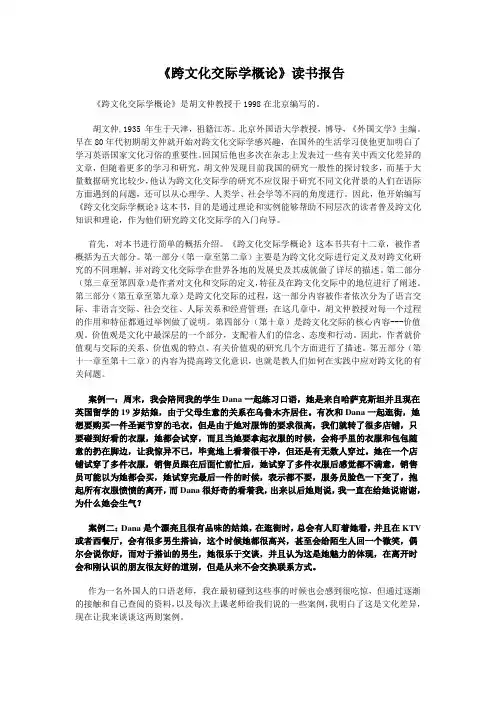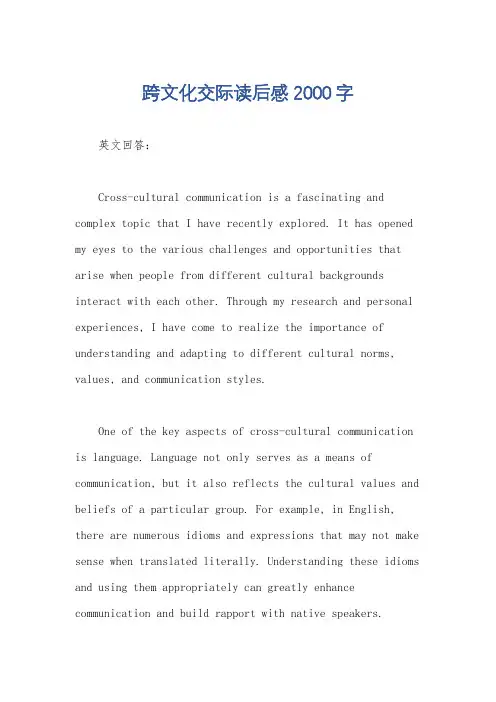跨文化交际--读书报告 完整版
- 格式:doc
- 大小:47.50 KB
- 文档页数:5

《跨文化交际学概论》读书报告《跨文化交际学概论》是胡文仲教授于1998在北京编写的。
胡文仲,1935 年生于天津,祖籍江苏。
北京外国语大学教授,博导,《外国文学》主编。
早在80年代初期胡文仲就开始对跨文化交际学感兴趣,在国外的生活学习使他更加明白了学习英语国家文化习俗的重要性。
回国后他也多次在杂志上发表过一些有关中西文化差异的文章,但随着更多的学习和研究,胡文仲发现目前我国的研究一般性的探讨较多,而基于大量数据研究比较少,他认为跨文化交际学的研究不应仅限于研究不同文化背景的人们在语际方面遇到的问题,还可以从心理学、人类学、社会学等不同的角度进行。
因此,他开始编写《跨文化交际学概论》这本书,目的是通过理论和实例能够帮助不同层次的读者普及跨文化知识和理论,作为他们研究跨文化交际学的入门向导。
首先,对本书进行简单的概括介绍。
《跨文化交际学概论》这本书共有十二章,被作者概括为五大部分。
第一部分(第一章至第二章)主要是为跨文化交际进行定义及对跨文化研究的不同理解,并对跨文化交际学在世界各地的发展史及其成就做了详尽的描述。
第二部分(第三章至第四章)是作者对文化和交际的定义,特征及在跨文化交际中的地位进行了阐述。
第三部分(第五章至第九章)是跨文化交际的过程,这一部分内容被作者依次分为了语言交际、非语言交际、社会交往、人际关系和经营管理;在这几章中,胡文仲教授对每一个过程的作用和特征都通过举例做了说明。
第四部分(第十章)是跨文化交际的核心内容---价值观。
价值观是文化中最深层的一个部分,支配着人们的信念、态度和行动。
因此,作者就价值观与交际的关系、价值观的特点、有关价值观的研究几个方面进行了描述。
第五部分(第十一章至第十二章)的内容为提高跨文化意识,也就是教人们如何在实践中应对跨文化的有关问题。
案例一:周末,我会陪同我的学生Dana一起练习口语,她是来自哈萨克斯坦并且现在英国留学的19岁姑娘,由于父母生意的关系在乌鲁木齐居住。

跨文化交际工作总结报告
在当今全球化的社会中,跨文化交际工作变得越来越重要。
跨文化交际工作是
指在不同文化背景下进行沟通和合作的工作。
在这样的环境中,人们需要更多的跨文化交际技能来有效地与不同文化背景的人进行交流和合作。
在这篇报告中,我们将总结跨文化交际工作的重要性,以及如何提高跨文化交际能力。
首先,跨文化交际工作的重要性不言而喻。
在全球化的今天,越来越多的公司
和组织需要与来自不同文化背景的人进行合作。
这就需要员工具备跨文化交际能力,能够理解和尊重不同文化的习俗和价值观,从而更好地进行合作。
此外,跨文化交际工作也有助于促进文化交流和理解,有利于不同文化之间的和谐共处。
其次,提高跨文化交际能力是至关重要的。
为了更好地进行跨文化交际工作,
我们可以通过多种方式来提高自己的跨文化交际能力。
首先,我们可以学习和了解不同文化的习俗和价值观,尊重并适应不同文化的方式。
其次,我们可以通过学习外语来拓宽自己的视野,更好地与不同文化背景的人进行交流。
此外,我们还可以通过参加跨文化交际培训和交流活动来提高自己的跨文化交际能力。
总之,跨文化交际工作在当今社会变得越来越重要,我们需要具备更多的跨文
化交际能力来更好地适应这样的环境。
通过不断地学习和提高自己的跨文化交际能力,我们可以更好地与不同文化背景的人进行合作,促进文化交流和理解,为全球化社会的发展做出贡献。

跨文化交际单元报告范文尊敬的老师、亲爱的同学们:大家好!我很荣幸能在今天分享我的跨文化交际单元报告。
本次报告以"跨文化交际"为主题,主要介绍了该领域的重要性、挑战和成功的案例。
我希望通过本次报告能够提高大家的跨文化意识,并为未来的跨文化交际提供一些启示。
跨文化交际,顾名思义,即涉及不同文化背景个体之间的交流与互动。
在当今全球化时代,跨文化交际已成为一种必不可少的技能。
它不仅帮助我们理解他人的想法和行为,也促进了跨国企业的合作和文化多样性的发展。
然而,由于每个人所处的文化背景不同,跨文化交际也带来了很多挑战。
首先,跨文化交际面临的一个挑战是语言差异。
不同的语言代表了不同的文化观念和价值观。
当我们尝试与来自不同国家的人沟通时,语言障碍常常成为一个问题。
此外,即使使用相同的语言,不同的口音、语法和词汇使用也可能导致误解或不清楚的信息传递。
其次,文化差异也是跨文化交际中的挑战之一。
不同的文化对待时间、个人空间、礼貌和社交规则等方面有着不同的理解和解释。
因此,一个动作在一个文化中可能被视为礼貌或友好,但在另一个文化中可能被认为是侵犯个人隐私或无礼的。
这种文化差异容易导致误解和冲突,需要我们具备辨别和尊重不同文化的能力。
最后,跨文化交际中的价值观冲突也是一个重要的挑战。
每个文化都有自己的价值观和道德观念。
当这些不同的价值观碰撞时,很容易引发误解和冲突。
例如,在一个文化中,个人主义和竞争精神可能被高度重视,而在另一个文化中,集体主义和合作可能更受重视。
理解和尊重不同的价值观是跨文化交际中的关键。
尽管跨文化交际存在挑战,但也有许多成功的案例。
例如,跨国企业的成功合作就需要不同文化背景的员工理解和尊重彼此的差异。
另外,跨文化交流能够增进国家间的友谊和合作,促进文化多样性的发展。
这些成功的例子表明,通过适当的沟通技巧、尊重和关注对方的文化贡献是跨文化交际成功的关键。
那么,如何提高跨文化交际的能力呢?首先,我们应该增强自己的跨文化意识。

跨文化交际个人总结报告一、跨文化交际是在不同文化背景下进行交流和合作的过程。
我在过去的一段时间里,有幸参与了跨文化交际的项目和活动,深刻体验到了文化差异对交流和合作的影响。
本报告将对我个人在跨文化交际中的体验和成长进行总结。
二、文化差异的认知在跨文化交际中,我深切感受到了文化差异的存在。
首先,语言差异成为了沟通的一大挑战。
不同国家和地区的语言风格、表达方式各异,可能导致理解上的困难。
其次,价值观和习惯的差异也是一大阻碍。
在一些文化中,某些行为可能被视为礼貌,而在另一些文化中可能被解读为不尊重。
三、学习他人文化为了更好地融入跨文化环境,我努力学习和理解他人的文化。
我主动参与当地的文化活动,尝试传统食物,了解当地的习俗和传统。
通过这些亲身体验,我更好地理解了他人的生活方式和价值观,建立了更加深厚的人际关系。
四、尊重和接纳差异在跨文化交际中,我深知尊重和接纳差异的重要性。
不同的文化有着各自独特的优势和价值,而不是谁高谁低的关系。
我在交往中始终保持开放心态,尊重他人的文化传统,接纳多元化的观点。
这不仅有助于构建和谐的人际关系,也促进了团队的合作。
五、沟通技巧的提升在跨文化交际中,良好的沟通技巧尤为关键。
我学习采用简明扼要的语言表达自己的意思,避免使用可能产生歧义的词汇。
同时,我更注重倾听,努力理解对方的观点。
通过提升沟通技巧,我能够更有效地与不同文化背景的人建立联系,达成共识。
六、解决文化冲突文化冲突是跨文化交际中常见的问题。
我在实践中学到,及时的沟通和解释是解决文化冲突的有效途径。
当出现误解或不适应时,我会主动寻求对话,解释自己的观点,同时倾听对方的看法。
通过开放的沟通,我成功化解了一些潜在的文化冲突,保持了合作关系的稳定。
七、个人成长和收获通过参与跨文化交际,我不仅拓宽了自己的视野,还提升了许多软技能。
我学到了更灵活的沟通技巧、更广泛的人际交往能力,更重要的是培养了更高的文化敏感度。
这些在职业发展和个人生活中都起到了积极的作用。

跨文化交际读后感2000字英文回答:Cross-cultural communication is a fascinating and complex topic that I have recently explored. It has opened my eyes to the various challenges and opportunities that arise when people from different cultural backgrounds interact with each other. Through my research and personal experiences, I have come to realize the importance of understanding and adapting to different cultural norms, values, and communication styles.One of the key aspects of cross-cultural communication is language. Language not only serves as a means of communication, but it also reflects the cultural values and beliefs of a particular group. For example, in English, there are numerous idioms and expressions that may not make sense when translated literally. Understanding these idioms and using them appropriately can greatly enhance communication and build rapport with native speakers.Similarly, in Chinese, there are many idioms and proverbs that carry deep cultural meanings and can be used to convey complex ideas in a concise manner.Another important aspect of cross-cultural communication is non-verbal communication. Different cultures have different norms and expectations regarding body language, gestures, and personal space. For example, in some cultures, maintaining eye contact is a sign of respect and attentiveness, while in others, it may be considered rude or confrontational. Being aware of these cultural differences and adapting one's non-verbal communication accordingly can help avoid misunderstandings and create a positive impression.Furthermore, cultural values and beliefs play a significant role in cross-cultural communication. For instance, in some cultures, hierarchy and respect for authority are highly valued, while in others, individualism and equality are emphasized. Understanding these cultural differences can help avoid conflicts and misunderstandings. For example, in a business setting, knowing whether toaddress someone by their first name or using a more formal title can greatly influence the dynamics of the interaction.In addition to language, non-verbal communication, and cultural values, it is also important to be aware ofcultural differences in terms of time management, decision-making processes, and negotiation styles. For example, in some cultures, punctuality is highly valued and being late for a meeting can be seen as disrespectful, while in others, a more relaxed approach to time is accepted. Similarly, some cultures prefer a direct and assertive negotiation style, while others value harmony and indirect communication.中文回答:跨文化交际是一个令人着迷且复杂的话题,我最近对此进行了探索。

跨文化交际学概论读后感我得先吐槽一下,以前我以为跨文化交际不就是不同国家的人见面打个招呼、说几句外语嘛,能有多复杂?这本书一上来就给我来了个下马威,告诉我这里面的门道可深了去了。
就像你以为打开了一扇小木门,结果发现后面是一座超级大迷宫。
书中提到的那些文化差异,真的是让我惊掉下巴。
比如说时间观念,在有些文化里,精确到分钟那是基本操作,约会迟到几分钟就像是犯了大罪;而在另一些文化里,时间就像是有弹性的橡皮筋,“一会儿”可能是半小时,也可能是两小时,这要是两个来自不同文化背景的人约个会,那可不得急死一个、气晕一个啊。
还有关于身体语言的部分,简直是让我大开眼界。
我以前从来没想过,一个简单的手势在不同文化里能有完全相反的意思。
在咱们这儿竖起大拇指是点赞,表示厉害;可在有些地方,这个手势可能就不那么友好了。
这就好比是同一种药,在这个地方是治病的良方,到了另一个地方就成了毒药,你说吓人不吓人?读这本书的时候,我就像是在看一部超级有趣的文化纪录片,但又比纪录片更深入。
作者把那些抽象的文化概念用一个个鲜活的例子给串起来,就像用竹签串糖葫芦一样,让我轻松地就把这些知识给“吃”进去了。
而且每读完一个章节,我就忍不住去想我身边有没有这样的跨文化交际场景,还真被我发现不少。
比如说我们学校的外教,以前我总是不理解他为什么有时候对我们的一些行为反应那么奇怪,读完这本书才明白,原来是文化差异在捣鬼。
这本书也给了我不少启示。
在这个全球化的时代,跨文化交际几乎是每个人都会遇到的事情。
不管是出国旅游、留学,还是在国内和外国友人打交道,了解这些跨文化交际的知识就像是给我们自己配备了一个文化翻译器。
我们可以避免很多不必要的误会,还能更好地去欣赏不同文化的魅力。
我现在感觉自己像是一个掌握了秘密武器的文化小使者,下次再遇到不同文化背景的人,我就可以更加自信地去和他们交流,说不定还能成为跨文化交际的小达人呢!总的来说,这本书就像是一把钥匙,打开了我对不同文化理解的新大门,让我在这个多元文化的世界里能更加自在地穿梭。

跨文化交际概论读后感以前我觉得文化嘛,不就是大家吃不同的食物,穿不同的衣服。
但这本书就像一个严厉又耐心的老师,把我的这种肤浅认知直接打翻,然后重新给我构建了一个超级复杂又超级有趣的跨文化交际世界。
书里提到的那些不同文化之间的差异,简直比我想象的还要多。
比如说时间观念,在有些文化里,人们就像精确的时钟,约会迟到几分钟就觉得是天大的罪过;而在另一些文化里呢,时间好像是个很有弹性的东西,“马上到”可能意味着还有半小时甚至更久。
这要是两边的人碰到一起,估计一个得急得冒烟,另一个还觉得莫名其妙呢。
还有关于面子的问题。
不同文化对面子的定义和重视程度也是千差万别。
有些文化里,在公众场合批评人就像是往人家脸上扔泥巴,是绝对不被允许的;而在另一些文化中,大家似乎更能接受直接的批评,觉得这是改进的好机会。
我就想啊,如果不了解这些,那在跨文化交往中得多容易踩雷啊,一不小心就把人家得罪了,自己还不知道咋回事儿。
书中那些生动的例子也特别吸引我。
就像不同国家的人在商务谈判中的表现。
有的国家的人谈生意的时候,先得聊个天,从天气到家庭,像老朋友一样热络一番,才慢慢切入正题;可有的国家的人呢,上来就直奔主题,谈完事儿拍拍屁股走人,一点不拖泥带水。
这要是两个风格不同的人坐到谈判桌前,没点跨文化交际的知识,估计得把谈判搞成一场混乱的闹剧。
从语言的角度看也特别有趣。
同样一句话,在不同的文化语境里可能有完全不同的含义。
我记得有个例子说,某个手势在一种文化里表示友好,到了另一种文化里可能就是一种侮辱。
这就好比是同一种密码,在不同的地方被解读成完全不同的信息,要是不小心用错了手势,那可就相当于发出了错误的信号,可能引发一场不必要的误会大战呢。
读这本书还让我意识到,跨文化交际可不仅仅是为了那些要出国的人或者做跨国生意的人准备的。
在我们这个全球化的时代,哪怕你就坐在家里,也随时可能和不同文化背景的人打交道。
网络让世界变得这么小,说不定你在网上玩个游戏,都能遇到来自地球另一端的小伙伴,要是不懂点跨文化交际的知识,可能连游戏都玩不顺畅呢。

《跨文化交际》祖晓梅读后感篇一《跨文化交际》祖晓梅读后感嘿,朋友们!最近我读了祖晓梅老师的《跨文化交际》,哎呀呀,这可真是让我大开眼界!也许在很多人眼里,跨文化交际就是简单的和外国人说说话,交流交流。
但读了这本书,我觉得完全不是这么回事儿!它就像一个神秘的宝盒,打开之后,里面的精彩超乎想象。
书里讲了好多有趣的例子,让我仿佛置身于各种不同文化的碰撞之中。
比如说,不同国家对于时间观念的差异,这可太有意思了!像有些国家,时间就是金钱,分秒必争;可有些地方呢,时间就是慢悠悠的河流,随意流淌。
我就在想,那要是这两种文化的人碰到一起,不得急死一方,笑死另一方啊?还有饮食文化的差异,这也让我感触颇深。
咱们中国人讲究团圆,大家围坐在一起,热热闹闹地吃饭。
可有些西方国家,一人一份餐,自顾自地吃。
我就问了,这样难道不会觉得有点孤单吗?不过,读的过程中我也有点犹豫。
可能跨文化交际有时候也会带来一些冲突和误解吧。
比如说,不同的礼仪习惯,也许一不小心就会冒犯到别人。
但反过来想,这是不是也是一个互相学习、互相理解的好机会呢?读完这本书,我觉得自己好像站在了一个更高的地方,看到了世界的多样性。
难道我们不应该多去了解、多去包容其他文化吗?不然,我们不就成了那只“井底之蛙”,只看到自己头顶那一小片天空啦?总之,这本书真的太棒啦!让我对跨文化交际有了全新的认识,这一路读下来,真好!篇二《跨文化交际》祖晓梅读后感朋友们,我刚读完祖晓梅的《跨文化交际》,这感受,真是一言难尽啊!一开始,我觉得这书可能会很枯燥,毕竟“跨文化交际”这几个字听起来就挺高大上的。
但没想到,读着读着,我就被深深吸引了!书里提到的那些跨文化的故事和案例,就像一部部精彩的电影在我眼前放映。
比如说,不同国家对于礼物的看法和赠送方式,那差别可大了去了!咱们中国人送礼物讲究心意和面子,要精挑细选;而有些国家,可能随便一点小玩意儿就能当作礼物。
我就寻思,这要是咱们按照自己的习惯去送,人家会不会觉得太隆重或者太随便了呢?还有语言交流中的误会,那真是让人哭笑不得。

跨文化交际学概论读后感一翻开书,我就感觉自己像是个准备踏上星际冒险的小菜鸟,要去探索不同文化星球的奥秘。
书里讲的那些文化差异啊,一开始真让我惊掉下巴。
比如说时间观念,在有些文化里,准时那是像呼吸一样自然的事儿,要是迟到个几分钟,就跟犯了天大的错似的;可在另外一些文化里呢,时间就像橡皮筋,可以拉得长长的,晚个半小时一小时好像也没什么大不了。
我就想啊,要是这两种文化的人凑一块开会,那不得乱套了,一方在那干着急,另一方还慢悠悠地晃悠过来呢。
书中提到的语言在跨文化交际里的作用也特别有趣。
我以前觉得语言嘛,不就是说话交流,把自己的想法表达出来就得了。
可没想到,同样一句话,在不同文化背景下能有天差地别的意思。
就像那个简单的“yes”和“no”,在有些文化里可能就是直来直去的表达同意或者不同意,但在其他文化里,“yes”可能只是表示“我听到你说话了”,而不是真的同意。
这要是不小心理解错了,那可就尴尬大了,就像你以为别人答应跟你一起去玩,结果人家只是礼貌性地回应,最后你一个人傻愣愣地等在那儿。
还有非语言交际部分,这可真是个隐藏的大宝藏。
眼神交流、肢体动作、身体距离这些,每一个细节都像是不同文化编写的密码。
有些文化里,说话的时候盯着对方的眼睛是诚实和尊重的表现;可在另外一些文化里,一直盯着人家看那就是挑衅了。
我想象自己要是到了一个不了解这些规则的地方,可能随便站一下或者动一下,就冒犯到别人了,自己还浑然不知,就像个没头的苍蝇到处乱撞,在人家的文化雷区里蹦跶。
通过读这本书,我感觉自己就像个文化侦探。
以前走在街上看到不同肤色、不同打扮的外国人,就只是觉得新鲜。
现在啊,我会忍不住猜测他们背后的文化习惯,他们的行为举止是不是有什么特殊的文化含义。
这本书就像是给了我一个放大镜,让我能够更加细致地观察这个多元的世界。
不过呢,这本书也让我有点小烦恼。
因为了解了这么多文化差异之后,我突然觉得人际交往变得好复杂啊。
就好像面前突然出现了无数条弯弯曲曲的小路,我得小心翼翼地选,生怕走错一步就踩了文化的“地雷”。

第一章读书报告非常高兴能够在李岗老师的带领下开始跨文化传播的研究之旅,之所以会选择跨文化研究这们课程是认识到这种传播现象在传播学研究的重要性,它不但涉及到我们这个时代个人生活的微观层面,同时也涉及国家、民族及其关系,以及全球化等等宏大主题,更重要的是成为传播学中一个重要且普遍的子学科。
第一章主要讲了跨文化传播研究的产生背景,作者首先为我们列出了其产生的实践渊源就是来源于本尼迪克特在战时为帮助美国政府研究日本文化而做的调查报告,和爱德华霍尔根据自己在二战期间在多国进行的实际经历而编写的<无声的语言>. 正是因为在实践中发现了不同文化之间的交流特点与冲突,想要更好的把握其规律,进一步达成有效传播才使跨文化传播学进一步得到创立。
其次,跨文化传播研究的发展是因为现实的需要,经济全球化必然带来世界范围内的贸易和交流,想要有效交流就必须互相去了解对方甚至多方的文化,而了解完他国或是不同的文化之后就要根据不同的文化特点进行有目的的沟通,我认为这就是一种跨文化传播。
定义中说,跨文化传播指的是来自不同文化背景的个体、群体或组织之间进行的交流活动。
任何交流都会有摩擦和冲突,但是如果我们能掌握一些跨文化传播的规律和技巧,就能减少一些不必要的矛盾。
最后,跨文化传播研究是传播学发展的内在要求,传播学是一门及其内容丰富和开放的学科,传播学所要研究的不只是传播系统内部的媒介环境现象,而是从一定角度研究整个世界,即还研究包括传播系统外部的社会环境现象,诸如规范因素、价值因素、经验因素、关系因素以及政治、经济、道德、法制、文化等社会意识的综合情况等等。
且传播学在创立之初就和社会学和心理学密切相关,只要是能够对传播产生影响的因素都必须要放在我们的研究范围之内。
文化因素深深烙印在社会的政治、经济、道德、法制、文化等社会意识形态中,对其产生重要影响,所以我们研究跨文化研究对更加准确的把握传播规律就更为重要。
通过第一章的学习,我也扫了一点盲,知道了是美国学者爱德华·霍尔首先提出了跨文化传播(cross-cultural communication)的相关概念,并于20世纪50年代创立了跨文化传播学的研究。

《跨文化交际》祖晓梅读后感1. 我读完 《跨文化交际》祖晓梅这本书后,就像打开了一扇通往世界的新大门。
我心里直犯嘀咕,这跨文化交际不就像不同口味的糖果混在一起吗?我跟同桌说:“你说不同国家的人交流,是不是就像我吃甜粽子,你却只爱咸粽子,可咱们还得坐一块儿分享美食?”有次我去参加国际文化交流活动,看到外国小伙伴对我们的书法好奇得眼睛放光,我才明白,这就是文化在“交朋友”呢。
2. 祖晓梅老师书里提到文化差异可大了。
我就想,这是不是像我们班男生和女生的差别?男生爱踢球,大喊大叫满操场跑。
女生呢,喜欢安静地画画。
我问班长:“你说让男生陪女生画画,女生陪男生踢球,是不是就像让美国人过春节,中国人过感恩节一样难?”上次学校组织文化周,让我们互相体验不同兴趣小组,那场景啊,就像书里说的文化碰撞,有趣又有点小混乱。
3. 书里讲语言在跨文化交际里可重要了。
我就纳闷儿,这语言不就是不同的“魔法咒语”吗?我跟外教聊天,我讲的英语磕磕巴巴,外教说的中文也怪怪的。
我忍不住说:“您这中文像刚学走路的小娃娃,我这英语像没头的苍蝇。
”就像我去旅游,到了地方语言不通,比划半天对方也不懂,那时候才知道,能好好说话多重要,这跨文化交际没语言这把“钥匙”可不行。
4. 我看到书里说文化习俗的部分,脑袋里就像有个小鼓在敲。
我问妈妈:“外国人见面亲脸颊,我们见面握手,这是不是就像白天鹅和黑天鹅,看着不一样,其实都很美?”记得有外国朋友来家里做客,他们对我们用筷子吃饭好奇极了,我教他们,就像传播一个神秘的文化宝藏,大家嘻嘻哈哈,这就是跨文化交际的乐趣吧。
5. 祖晓梅在书里提到跨文化交际中的误解。
我就着急地想,这误解了可咋整?我跟小组同学讨论:“要是把外国的礼貌当成了热情过度,是不是就像把猫当成了老虎,吓一跳还闹笑话?”上次我送外国同学一个小礼物,包装很简单,他好像有点失望。
后来我才知道,在他们那儿包装也很重要。
这就告诉我们,跨文化交际得多了解对方啊。
跨文化交际读书报告学院: 外国语学院班级: 07级本科2班学号: *****************时间: 2010-5-21Book reportJourney to the West 西游记Wu Cheng−en【明】吴承恩Journey to the West is one of the Four Great Classical Novels of Chinese literatures. Originally, published anonymously in the 1590s during the Ming Dynasty. It is a Chinese mythological novel. It was written during the Ming Dynasty based on traditional folktales. Consisting of 100 chapters, this fantasy relates the adventures of a Tang Dynasty (618-907) priest Sanzang and his three disciples, Monkey, Pig and Friar Sand, as they travel west in search of Buddhist Sutra. The first seven chapters recount the birth of the Monkey King and his rebellion against Heaven. Then in chapter eight to twelve, we learn how Sanzang was born and why he is searching for the scriptures, as well as his preparation for the journey.As we known, this book is widespread in china, even in the whole world. The book has been adapted so many times for film and television. The most famous Chinese live action TV series is produced by CCTV in 1986, starring Liu Xiao Ling Tong as Sun Wu Kong, and directed by Y ang Jie. It follows the original storyline faithfully and is widely regarded as a classic. I have seen this one more than ten times, but I read this book a month ago. What make me feel surprised is that book has more deeply impressments on me than the TV series. Because some of the characters in the book were removed or altered in the screenplay, and the movie couldn‟t totally express the author‟s thoughts and mixed with the director or other people‟s ideas more or less.In this book, my favorite character is monkey king who is the first hero in most Chinese children heart .He is born from a rock on the summit of Flower Fruit Mountain and goes on to become the king of the monkeys. 300 years later, he learns the way of immortality and various other powerful magical skills from an immortal far away from his home. However, Wu Kong is captured and rushes Wu Kong underneath the Mountain of Five Elements by Buddha after a series of events, which includes Wu Kong defeating the Heavenly warriors sent to capture him and waving a terrible war between Heaven and Flower Fruit Mountain. 500 years later, Tang San Zang rescues Sun Wu Kong from the mountain. They meet Zhu Ba Jie and Sha Wu Jing later who become San Zang's disciples. They start on the pilgrimage to the Western Heavens together.At first, he is defiant and bold just because he is powerful, and he knows that noone can defeat him. He has mastered seventy-two methods of transformations and can also do a jīndǒuyún ("cloud somersault").At the Mountains of Flowers and Fruits, he dare to defeat an army of 100,000 celestial soldiers, led by the Four Heavenly Kings, Erlang Shen, and Nezha.he has never thought that he may be defeated and wants to place the Heavenly Emperor. Wu Kong is afraid of nothing. There is no doubt that Wu Kong‟s most prominent personality trait is bravery and fearlessness.Later, another interesting aspect of his personality is the development of his relationship with Tang San Zang. Before meeting Tang San Zang,Wu Kong goes around killing off humans for no reason at all and does things freely. So Guānyīn teaches San Zang to chant the Tightening-Crown spell whenever he needs to chastise Wu Kong. Finally Wu Kong is tortured into obedience to San Zang. But, strangely, it all changes during the pilgrimage. Wu Kong seems to grow affection for the monk. Wu Kong only wants to protect San Zang. When San Zang makes him leave, thinking that he killed three innocent humans when in fact they were the same demon in disguise, Wu Kong cries over his master. And I cries too when I read this chapter. He cries not for uselessness, but Wu Kong just reacts more emotionally and dramatically to some things. He starts to be human.All in all, Wu Kong is a confident, optimistic person. He doesn't just go down when facing hardships; he devises ways to overcome them, putting a smile on his face even when he has been defeated numerous times. The most intelligent and violent of the disciples, he is constantly reproved for his violence by San Zang. In short, Sun Wu Kong symbolises hope, justice, and the fighting spirit that we all possess. He made Journey to the West the literary success it is now.Besides the monkey king‟s prominent personality, some other thing should be mentioned. The story tells of many hardships. But no matter how hard, they can succeed at last. Why? Why can they overcome any kinds of difficult and finally reach the Western Heavens and bring back the scriptures to China .what‟s more, Tang San Zang and his disciples attain Buddha hood in the end of story. In my opinion, it is not just because of three disciples‟ power. The most important key is their faith that they firmly believe they can achieve the goal .their confidence and courage result in their success. If we can understand it and apply to our study or work, we‟ll necessarily benefit fro m it.Book reportDeath on the Nile 尼罗河上的惨案Agatha Christie【英】阿加莎·克里斯蒂The acknowledged queen of detective fiction, Agatha Christie was born in 1890 in Torquay, County Devon, England. In her lifetime, she authored 79 crime novels and a short story collection, 19 plays, and six novels written under the name of Mary Westmacott. Agatha Christie is the biggest selling novelist in history. Her popular whodunits have been enjoyed by readers all over the world for nearly a century and translated into more languages than Shakespeare. Her books are famous for their clever and surprising twists of plot, especially Death on the Nile and Murder on the Orient Express.Death on the Nile is the first Agatha Christie novel I read. At first, I read the book just because it is thick enough that can help me kill time when I am bored or in a daze in my dormitory. However, I realize gradually that it is an extreme insult to Agatha Christie to read this novel just for whiling away the time. There is no doubt that her works are worth chewing and digesting instead of tasting. As an Agatha Christie fan, I must say that this is her BEST novel.Death on the Nile was written after her coming back from a winter in Egypt. And it was a book that Agatha Christie clearly enjoyed writing, imbued with her own fascination and love for Ancient Egypt. Christie had ever said that the book was one of the best of her “foreign travel” ones, and if detective stories are “escape literature”, the reader can escape to sunny skies and blue water as well as to crime in the confines of an armchair.The book has a lot of characters and a very elaborately worked out plot. I think the central situation is intriguing and has dramatic possibilities, and the three characters, Simon, Linnet, and Jacqueline .of course, the main character is always Hercule Poirot who is the worlds best, and perhaps most eccentric detective. A renowned Belgian detective, of almost comical appearance, described as having an egg shaped head and well-manicured black moustache; he is obsessed with order and symmetry and dresses smartly and precisely. He famously employs his …little grey cells‟ to uncover the psychology of the murderer and is world-renowned for hissuccess. in this story, Hercule Poirot plans a case free holiday voyage down the Nile, but the shooting death of a beautiful young heiress on her honeymoon calls him from relaxation to work. The appearance of his friend Inspector Race who is following another case is an unexpected pleasure as the two men work well together.Agatha Christie has such an ability of leading you to believe something and then snatching it away from you and leaving you in question. This makes a good mystery novelist! The plot around the death in this novel is flawless and there's no question left in the minds of the reader once the mystery is unfolded. The author, as usual, kept me waiting till the very end to find out the solution to the mystery - and I experienced extreme pleasure on reading the end. Wow, this is definitely a masterpiece, and one of Christie's best works.I had to say that this book offer us a complex tale of emotional fury, considerable atmosphere. When I read this book, I always considered me as Poirot. I read the crime took place in the moment, probably already guessed who the murderer. As usual I never got it right, but it's always fun to try. What made me feel depressed was that I often ignored a lot of details. The outcome of confirmed my guess is totally wrong. However, Often after reading his explanation of events, I've thought to myself, "Why didn't I spot that?" and flicked back through the book to see what I didn't pick up when I first read it. But surprisingly, the clues are obvious.I found that reading this kind of book need good understanding about some specific words. Details are important. If you guess not depend on details, but intuitions. Mostly, you are wrong. Commonly, guessing words may affect the understanding about the whole crime. Words can not really tell, but also guess from the spelling part of speech. Very often, is just enough to know that part of speech. For example: "Hercule Poirot shook his head and shuddered slightly." Investigation did not have time to "shudder", but it is easy to see that it is an action, detective Poirot to know a little "shudder" then, it is enough. And large landscape descriptions or more characters do not have to look at the description of appearance, as they push forward with the cases not directly linked.All in all ,I would say it is well worth a read if you're after something easy-going and mindless. The setting, the isolation of the characters to build up a claustrophobic feel, and a fantastic solution that leaves you stunned all make for a great read. It's an absolute classic.。
跨文化交际读后感在这个全球化的时代,跨文化交际变得越来越常见。
读完关于跨文化交际的相关内容后,我真是感触良多啊!书里提到的各种案例和观点,让我不禁想起了自己曾经的一段亲身经历。
那是我第一次出国旅行,目的地是日本。
本以为会是一场轻松愉快的旅程,却没想到因为文化差异,闹出了不少笑话,也有了许多深刻的感受。
刚到日本的时候,我就被那里干净整洁的街道和彬彬有礼的人们所吸引。
我满心欢喜地拖着行李箱,走进了一家预定好的民宿。
房东是一位非常和蔼可亲的日本阿姨,她微笑着迎接我,还不停地鞠躬,那热情劲儿让我一下子放松了不少。
放下行李后,我想着出去逛逛,顺便找点吃的。
走进一家小餐馆,我看着菜单上那些似懂非懂的日文,心里有点犯嘀咕。
最后,我指了指图片上看起来像是拉面的东西,跟服务员点了餐。
不一会儿,面端上来了,看着还不错,我拿起筷子就准备大快朵颐。
可就在这时,我发现周围的人都在看着我,眼神里似乎有点异样。
我心里正纳闷呢,低头一看,哎呀!我居然直接就开吃了,而周围的日本人都在饭前双手合十,说着“いただきます”(我开动了)。
当时我那个尴尬呀,脸一下子就红了,赶紧也学着他们的样子,双手合十说了一句,这才开始吃面。
还有一次,我在街头迷路了,想找人问问路。
看到一位年轻的女士,我连忙跑过去,用我那蹩脚的英语跟她交流。
结果她一脸迷茫,似乎没太听懂。
我又连比划带说,费了好大的劲儿,她才终于明白了我的意思。
给我指路的时候,她那细致认真的样子真的让我很感动。
她不仅用手指着方向,还画了一张简单的地图给我,最后还一个劲儿地鞠躬,跟我说“頑張ってください”(加油)。
在日本的那几天,我发现日本人在公共场合说话都特别小声,而我这个大嗓门儿,有时候一激动声音就高了起来,引得周围人侧目。
坐地铁的时候,大家也都特别安静,有的人在看书,有的人在睡觉,整个车厢里安静得让人有点不适应。
逛商场的时候,我发现日本人的服务真的是太周到了。
不管你买不买东西,售货员都会一直保持着微笑,不停地鞠躬,让我都有点不好意思了。
《跨文化交际》祖晓梅读后感篇一跨文化交际》祖晓梅读后感最近读了祖晓梅老师的《跨文化交际》,哎呀,真的是让我感触颇多!你说这跨文化交际,咋就这么复杂又迷人呢?可能对于有些人来说,就是简单的不同文化的碰撞呗,但我觉得远远不止如此。
就像书里说的那些例子,不同国家的人对时间的观念都大不一样。
咱中国人可能觉得准时很重要,可有些国家的人也许就觉得随性一点没啥大不了。
这让我想到我之前认识的一个外国朋友,约好了见面的时间,我早早到了,他却迟到了好久。
当时我心里那个气呀,觉得这人咋这么不靠谱。
但后来读了这本书,我觉得可能是文化差异在作祟,也许在他的文化里,时间没那么严格。
再说饮食习惯,那差别更是大了去了。
咱们中国人吃饭爱热闹,大家围坐在一起,边吃边聊。
可有些国家的人喜欢安静地独自享用美食。
我就在想,这要是让一个习惯热闹的中国人去到那种安静的餐厅,不得憋出病来?不过呢,读这本书的时候我也在想,跨文化交际是不是有时候也会带来一些麻烦?比如说因为不了解对方的文化,造成了误会,甚至影响到了友谊或者合作。
这可咋办?也许我们得更加努力地去学习和理解不同的文化,才能避免这些问题。
但话说回来,这跨文化交际也有它超级棒的一面啊!它能让我们开阔眼界,体验到各种新奇的事物。
就像打开了一扇通往全新世界的大门,多刺激,多有趣!总之,读了祖晓梅老师的这本书,我觉得跨文化交际既是挑战,也是机遇。
我可得好好琢磨琢磨,以后怎么能在这个多元的世界里游刃有余。
篇二跨文化交际》祖晓梅读后感哇塞,读完祖晓梅老师的《跨文化交际》,我这脑袋里简直像炸开了锅!你说这世界咋就这么神奇呢?不同的文化,就像一个个色彩斑斓的拼图块,拼凑在一起,形成了一幅超级复杂又超级迷人的画卷。
书里提到的那些跨文化的故事,真是让我大开眼界。
比如说礼仪方面,有的国家见面要拥抱亲吻,咱中国人可能就觉得有点不好意思,甚至会觉得有点太过亲密了。
这让我想起有一次参加国际交流活动,一个外国友人上来就要拥抱我,我当时都愣住了,心里直犯嘀咕:“这啥情况呀?”还有语言表达,不同文化的幽默方式那可真是天差地别。
跨文化沟通力的读书报告引言跨文化沟通是在不同文化背景下进行有效交流和理解的能力。
随着全球化进程的不断加深,跨文化沟通能力对于个人和组织的成功变得越来越重要。
本文将探讨跨文化沟通的重要性、如何培养跨文化沟通力以及跨文化沟通中可能遇到的挑战。
重要性1.促进国际合作:跨文化沟通能力有助于建立国际合作关系,推动经济、政治和文化的交流与发展。
2.解决文化冲突:不同文化间存在差异,跨文化沟通能力可以帮助解决文化冲突,减少误解和偏见。
3.提高商务竞争力:随着市场的全球化,企业需要具备良好的跨文化沟通能力来拓展国际市场、与跨国公司合作,并更好地适应本土市场。
4.促进文化交流:跨文化沟通有助于不同文化间的艺术、音乐、文学等领域的交流与传播,促进文化的多样性与通盘发展。
培养跨文化沟通力1.学习目标文化:了解目标文化的历史、价值观、礼仪规范等,以便更好地理解该文化下的行为和态度。
2.学习目标语言:不同语言背后承载着不同的文化内涵,学习目标语言可以帮助更深入地理解目标文化。
3.尊重他人文化:尊重他人的文化差异,不以自我文化标准评判他人,避免文化优越感的产生。
4.开放心态:拥抱多元文化,接受和欣赏不同文化之间的差异,乐于接受新观念和认知模式。
5.发展社交技巧:学习如何在不同文化背景下进行礼貌而有效的交流,包括非语言沟通和对话技巧。
跨文化沟通中的挑战1.语言障碍:语言是文化的一部分,不同语言间的翻译和理解往往存在困难,可能导致信息传递不准确。
2.价值观差异:不同文化对于道德、权利、义务等方面有不同的看法,可能导致沟通误解和冲突。
3.文化偏见:由于个人的文化背景和经验的差异,可能会产生对其他文化的偏见和误解,阻碍理解和交流。
4.非语言沟通:不同文化对于姿势、面部表情、接触触碰等非语言沟通方式的理解和使用不同,可能导致误读。
总结跨文化沟通力的培养需要学习目标文化和语言、尊重他人文化、保持开放心态和发展社交技巧。
在跨文化沟通中可能会遇到语言障碍、价值观差异、文化偏见和非语言沟通等挑战。
什么是跨文化交际?跨文化交际,即本族语者与非本族语者的交际,也指任何在语言和文化背景方面有差异的人们之间的交际。
本学期通过本门课程的学习,让我学会了一下三点:一、如何正确的审视不同文化之间的差异,二、如何提高跨文化适应能力,三、如何提高跨文化的交流技能。
随着中国对外开放程度的逐渐深入,西方社会的人和事物越来越多地走进了我们的视野,在这种情况下,跨国域、跨民族、跨文化的经济和社会交往将会与日俱增,这就为我们提供了许多与西方接触和交流的机会,这对于我们加深对的西方社会的理解是一件好事,但这却并不是一件简单的事情,因为我们所面对的是陌生的国家和文化,思维方式、生活习惯和行为方式与我们迥然不同的人,在与之交往的过程中不可避免的会出现文化冲突的现象,这时在跨文化交际课堂中学到的东西便起了大用!我总结了一下中西方的差异主要集中在以下几点:一、在客观主体方面,西方人向外探索客观世界,强调真善美、爱智,注重理性科学,注重求异,科学和逻辑发现。
中国人向内探索个人世界,强调真善美、崇善,注重情感、伦理,注重求同,经验、感情。
二、在处理问题方面,西方人采取不撞南墙不回头的态度,中国人采取不可中直取,只可曲终求的态度。
不同文化背景的人们在交际时,经常出现的一个现象就是套用自身所在社会的行为规范来判定对方行为的合理性,由于双方的行为规范存在差异,常常会产生误解、不快甚至更坏的结果。
比如说中国人轻拍小孩子的头部表示一种友好,而在西方国家,这是一种极不尊重小孩子的做法,父母会对此非常愤怒。
所以说在跨文化交际中是否能够正确地识别和运用行为规范是保证跨文化交际顺利进行的重要因素。
要保障跨文化交际的顺利进行,就必须理解对方的行为规范,尤其是什么行为是被禁止的,最好的办法就是遵循入乡随俗的原则。
三、在发表个人看法时,西方人直言、直去,中国人谨言、拐弯。
四、在民族性格方面,西方人偏重功利,好走极端,与其他民族存在斗争,强调以力争天下。
跨文化交际的个人报告心得前言在当今社会,随着全球化的推进,跨文化交际变得越来越重要。
作为一个现代人,我也不可避免地需要和不同文化背景的人进行交流与合作。
在过去的一段时间里,我深刻体会到了跨文化交际的重要性以及需要注意的细节。
本篇个人报告将总结我在跨文化交际中所获得的心得体会。
了解文化差异首先,要进行有效的跨文化交际,就必须了解不同文化之间的差异。
不同国家和地区都有各自独特的价值观、信仰、习俗等,了解这些差异可以帮助我们更好地理解对方的行为和思维方式。
在面对不同文化背景的人时,我会尽可能多地了解他们的国家或地区特色,这样可以提高我和对方的交流效率。
尊重和包容在跨文化交际中,尊重和包容是至关重要的。
尊重他人的文化差异,并包容不同的意见和观点,可以建立良好的沟通和合作关系。
在与他人交流时,我会尽量避免使用可能引起歧视或冒犯的言辞,积极倾听对方的观点,并且对不同的意见持包容的态度。
这样,我与他人之间的互动更加融洽,有效避免了文化冲突的发生。
掌握有效的沟通技巧在跨文化交际中,掌握有效的沟通技巧是至关重要的。
由于语言和文化差异,对方可能会有不同的交流方式和习惯,这就需要我们学会从对方的角度思考问题,并根据对方的语言特点进行沟通。
有时候,为了更好地表达自己的意思,我会借助肢体语言和图表等辅助工具。
此外,用简洁明了的语言表达,避免使用难以理解的俚语和文化暗示,也是有效沟通的关键。
学会适应与理解在跨文化交际中,适应和理解是必不可少的。
意识到自己的行为和思维方式可能与对方存在差异,并主动去适应对方的文化背景,会使交流更加顺利。
我也会主动了解对方的价值观、习俗和习惯,在与对方交流时将这些因素纳入考虑,避免出现冒犯和误解。
学习自我反省和改进在进行跨文化交际时,不可避免地会发生一些误解和冲突。
这时,学习自我反省和改进就显得尤为重要。
及时发现自己的错误并承认,尝试主动与对方沟通解决问题,可以避免问题的扩大化。
我也会在交流结束后进行自我反思和总结,记录其中的不足之处,并努力改进,以便在下一次的跨文化交际中表现更好。
The Book Report on Intercultural CommunicationNow we are in an era of globalization, the connection between different people with various cultural backgrounds becomes closer and closer, so it is the high time that we should have an awareness to admit the diversity of cultures and respect the difference of cultures. In this book, we can have a general understanding of the intercultural communication. To be exact, it demonstrates some theories to help us to achieve effective communication; also it points out some barriers preventing the effective communication and lastly gives us some suggestions on how to communicate smoothly and effectively when we are in different contexts as well as how to improve our intercultural communication competence. In this report, I will try to write down what I have learned in each chapter and then talk about my personal view on intercultural communication.1,The knowledge I learn from Intercultural Communication1)cultureFrom chapter one, we can know that culture is the deposit of knowledge,experience,beliefs,values,actions,attitudes,hierarchies,religions, notions of time, roles, spatial relations, concepts of the universe, and artifacts acquired by a group of people in the course of generations through individual and group striving. It has five characteristics, that is to say, culture is learned, dynamic, pervasive, integrated and adaptive. Everyone has its cultural identity whether it is examined or conscious or not. In addition, under the influence of these factors such as economic, politic, race, social class and the like, we human beings formulate the subculture, co-culture and the subgroups which are deviant and temporary.2)Communication and intercultural communicationFrom chapter two, we can learned that the process of communication is composed by 9 parts, namely, sender message encoding channel receiver decoding feedback and noise and context in order. The communication process is dynamic, systematic, symbolic, irreversible, transactional, self-reflective and contextual. Wha t’s more, culture is closed related to communication. Besides that, we can also learn that there are four main forms of intercultural communication including international communication, interracial communication, interethnic communication and intracultural communication.3)culture’s influence on perceptionFrom chapter three, we can learn that culture, which teaches us how to process and understand the information obtained from our senses, plays an important part in our perception. The process of perception is divided into three stages. When we select some message we need from our various senses, then we will organize these useful messages and finally interpret them. Sometimes we need to overcome barriers to accurate perception, such as ignoring details, over-generation, focusing on thenegative and so on. So it is essential for us to improve our perceptual skills in intercultural communication. They are listed as follows:Increase our understanding of the perceptual processIncrease our observation acuityCheck our perceptionIncrease our awareness of perceptual inaccuracies and compensate for themRecognize the elements to which you contribute meaning.Develop social decentering, empathy, and other-orientation4)intercultural communication barriersFrom chapter 4, the author mainly talks about the intercultural communication barriers from three perspectives, namely, emotional, attitudinal and translation barrier. When we are not familiar with another culture, we will sometimes fell anxious and uncertain. We always assume the similarity instead of difference and take our own culture for granted. With regard to attitudinal problems, we are usually influenced by the sense of ethnocentrism, stereotyping, prejudice and racism due to our early socialization and social economic and psychological benefits. As for the translation problems, we need to guarantee the equivalence of vocabulary, idioms, grammar and syntax, experience, and concepts.5)Verbal intercultural coommunictionFrom chapter five, the author talks about the verbal communication. Verbal communication is achieved by language as well as cultural literacy. The meaning of words comes out of the context. There are five verbal communication styles in this chapter: derect/indirect; self-enhancement/self-effacement; elaborate/exacting/succinct; personal/contextual and instrumental/affective. In addition, languages are various from countries to countries, regions to regions and have different functions. We have dialects, sociolects, pidgin, taboo, euphemism and lingua franca which will make the communication more difficult. Finally the verbal communication can affect the written communication, especially in business written form. We need to adjust our way of writing when we approach different people with different cultural backgrounds, either in direct plan or indirect plan.6)Nonverbal intercultural coommunictionFrom chapter six, we know that apart from verbal communication, nonverbal communication, sending messages without using words, can also deliver more information to us as well as reflect our subconsciousness spontaneously. Nonverbal communication codes in a communicating setting can be divided into different categories, such as paralanguage, silence, proxemics, chronemiccs, oculesics, olfactics, haptics, kinesics, chromatics and attire. For example, when you are silent in a discussion, it will have some implications. Firstly, you are not for the ideas others put forward. Secondly, you are lack of ideas. Thridly, you are shy to express yourself.7)Cultural patternFrom chapter seven, we know shared beliefs, values, norms, and social practices that are stable over time and that lead to roughly similar behaviours across similar situations are known as cultural patterns. It affects our ways of thinking and acting. Wha t’s more, Edward T Hall’s introduces the high-context communication and the low context-communication that are essential to effective communication. In high-context communication, information is provided through gestures, the use of space, and even silence and don’t rely on verbal communication as their main information channel while the latter deliver the information mainly through the verbal messages. Then Kluckhohn and Strodtbeck put forward the value orientation, including human nature,person-nature, activity and relation. Lastly Hofstedde has identified four value dimensions that have a significant impact on behavior in all cultures. These dimensions are individualism and collectivism, uncertainty avoidance, power distance, and masculinity and femininity.8)Cultural influences on contextsIn chapter eight, we can know that meaning in communication is basically decided by context. Context may consist of the social, political, and historical structures in which the communication occurs. Communication in three areas is most influenced by context:business, education and health care. In the business field, management has become a crucial issue and the managing styles vary from culture to culture. In addition to management, business practices such as gift giving, negotiation, greetings are also posing problems for the business interaction. Also, people in different educational background hold different cultures’ beliefs, values and norms. Similarly, health care professionals rely on the context. The different concerns about reasons for illness, family member roles, gender roles and language prove to be problematic in the health context. So if we want to achieve smooth communication across different cultures, we need to be willing to accept and understand the different cultural patterns.9)Intercultural adaptationIn chapter nine, we learn about the intercultural adaptation. When we come into a new culture, we need to know how to adapt to a new culture. Many foreigners will face culture shock which is a double sword. We need to master some strategies for avoiding culture shock and engaging in intercultural adaptation. Firstly, we need to study the host culture and the local environment. Secondly, it is necessary to learn basic verbal and nonverbal language skills. Thirdly, we need to develop intercultural relationship with host nations and maintain an intimate social network. Fourthly, assuming the principle of difference and anticipating the failure events is helpful in intercultural adaptation.10)Intercultural communication competenceIn the last chapter, we learn that intercultural competence is now more vital than before because of economic, technological, demographic, and social justice concerns. Having a good competent intercultural communication can help us fulfill our objectives and make our behaviors appropriate to the context and at the same time to maintain a good relationship with the people we approach. Intercultural competence includes individual component and contextual component. What’s more, there are four dimensions of intercultural competence-knowledge, affective, psychomotor and situational features dimension. So in order to be successful intercultural communicator, we need to develop skills to and strategies. Such as♦Work to emphasize areas of similarity wit others♦Try to accept differing opinion♦Make your verbal messages consistent with your nonverbal messages♦Avoid dominating conversation♦Avoid being submissive in conversation♦Be a affirmer2,My view on intercultural communication1)The use and the importance t of intercultural communicationBefore I read this book, I have thought the culture conflicts exist between different countries with different culture background, but I am wrong, intercultural communication exists everywhere. People cannot live without intercultural communication. Even when they are alone or silent, people are bombarded with communication. Human communication is the ability to use language, the ability to exchange ideas with people around us in different cultures. Communication with others is inevitable to human beings. Communication which is very important to our humans is the vehicle by which people initiate, maintain, and terminate their relationships with others. so intercultural communication is becoming pervasive because of the development of transportation and technology.The intercultural communication is applied into many fields, such as economic, politic, education, technology, health care and so on. And we cannot deny that culture communication is a double sword. If we can have good command of different culture a nd follow the host’s culture, it will bring a lot of benefits to ourselves, if not, we will suffer from this.With the rapid development of the modern society, the benefits of the Intercultural communication become more and more obvious.Firstly, communicating and establishing relationships with people from different cultures can lead to a whole host of benefits, including healthier communities; increased international, national, and local commerce; reduced conflict; and personal growth through increased tolerance.Secondly, due to through open and honest intercultural communication, peoplecan work together to achieve goals that benefit everyone, regardless of group or culture, including the global community in the home, business, or neighborhood. Healthy communities support all community members and strive to understand, appreciate, and acknowledge each member. Our ability to interact with persons from different cultures brought us many benefits.Thirdly, because of cross-cultural exchange, we can learn about the other countries’ way of life, also we can understand their industry structure. Thus we can do commercial exchanges and academic communication with them. Only through the exchange, we can get more academic knowledge, our communication will be easier and there will be less conflict between people of different cultures.2)The ways to improve our intercultural communication skillsIn regard to improving our intercultural communication skills, firstly, we have to recognize that we will make mistakes, learn from them, adapt, and move on. A good beginning point is to recognize that people from different cultures are different—not better or worse, but simply different. Besides that, we shouldn’t take our own culture for granted. If we are able to do this, we can adjust and adapt our verbal and nonverbal messages accordingly and become proficient communicators.Secondly, educate ourselves about different cultures. Be open to learning about culture and develop a sincere interest in learning about others. If this is a work-related situation, inquire with Human Resources to see if there are courses or activities related to intercultural training. If you have encountered a new friend, search the internet or go to the library to find out facts about his cultural history.Thirdly, Pay attention to our tone and our body languages in speech. Understand that many cultures give specific meaning to tone and body language. What may be a simple reaction to us could be seen as disrespectful. Be aware of when and how we laugh during interactions. Raising our voice or intonation at certain times may be seen as aggressive.Fourthly, try to remove slangs or idioms from our speech especially we talk someone from different cultural backgrounds. Many words in slang are misunderstood across cultures. Slang is specific to culture and many times does not communicate in the same way across cultures. For example, in England a "fag" is a cigarette and an acceptable term. In the United States, this is seen as a derogatory term.In a word, in order to be a good and efficient communicator, it is essential for us to realize and learn these theories I talk above, show respect to the culture differences and accept the cultural diversity.。